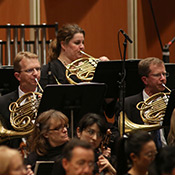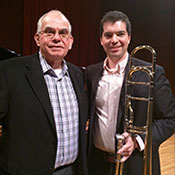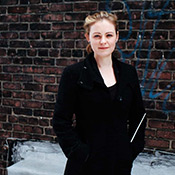
MSO Trombone Section Talks Instruments and Beethoven’s Fifth
David Lewellen
PUBLISHED
Tagged Under: 2019.20 Season, Brass, Classics, MSO Musicians
Three Milwaukee Symphony trombonists sit around a table, waiting for video equipment to be set up, and they talk about … trombones. (See that video here)
Normally, principal Megumi Kanda plays a tenor trombone, or sometimes an alto for high repertoire. Second trombone Kirk Ferguson almost always plays a tenor. Third trombonist John Thevenet almost always plays a bass trombone. But the exceptions make for good conversation.
Today, Ferguson is thinking about buying a new alto trombone, and Thevenet listens to audio clips of two models and gives his opinion.
“I don’t play alto as much as I would like,” Ferguson said. “All my time in the MSO, I’ve played it once.” But he used it on a recent freelance gig, a Catholic funeral Mass that had alto, tenor and bass trombones to double the choir.
“But we’ve got a lot of alto repertoire this year” for first trombone, he continues. “There’s Schumann coming up, and Beethoven 5 and 6.” Music written with the alto trombone in mind was common up through the early 19th century. The instrument fell into disuse in the 20th century, Kanda said, as most first trombonists played on a small-bore tenor, but now it’s making a comeback in appropriate repertoire.
“All Beethoven for me is alto,” Kanda says.
“I didn’t know there were trombones in Beethoven 6,” I say.
“Yes, there’s two. Basically, they just give the pitch to the timpani,” says Thevenet.
“Two trombones is pretty uncommon, isn’t it?”
The three trombonists come up with a few other examples – Copland’s Appalachian Spring, the Berg violin concerto. “But we’re better with three,” Kanda says.
“I thought that the Russian composers wrote for alto-tenor-bass?”
“Not necessarily,” Kanda says. “But Rimsky-Korsakov wrote all his solo parts for the second trombone. There was a very high-ranking government official in the orchestra who played second, and he wanted to look good.”
“So that’s why those parts are easy,” says Ferguson, the beneficiary.
“A lot of bass trombone parts are really more like third tenor parts,” says Thevenet. But he uses a bass trombone anyway, switching to a smaller mouthpiece for higher range. “I’ve only played a tenor trombone once in the MSO,” he says. “It said bass trombone for the first three lines, and then it said switch to tenor.”
Historically, trombones were busy in church choir lofts, with alto, tenor and bass instruments reinforcing those sections of the choir. Was there ever a soprano trombone? “Yes,” says Kanda. “It was a tiny little thing with a trumpet mouthpiece. But it died out.”
Mozart famously wrote for trombones in Don Giovanni, the Requiem and other works. Did Bach ever write for them? “Yes” say three voices almost in unison. “It’s in some choral pieces, and they usually follow the choir,” Ferguson says. “But not in all editions.”
“Usually it’s when the choir is weak,” Kanda says with a grin. “But sacred music in general. If it says Missa in the title, we have to get ready for a serious workout. It’s very high, and you don’t get any break.”
“No break is the biggest challenge,” Ferguson says.
“High isn’t a problem for bass trombone in that kind of work,” Thevenet says. “But we played one Schubert Mass where there was more written for trombone than there was for the cellos.”
“Yes, we’re always used for sacred music.”
“And then in the Romantic period we go to the other end,” Thevenet says.
“Right,” says Kanda. “We’re usually God or the devil.”



